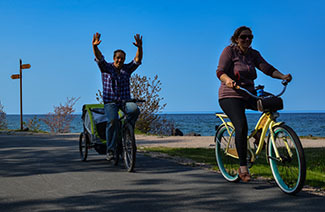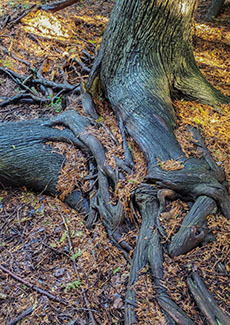|
Editor’s note: While the DNR is working hard to protect public health and safety during the coronavirus outbreak, we also recognize the value in looking forward, in reminding us all that Michigan is home to amazing natural and cultural resources surrounded by stories that are worth sharing. We hope articles like this help provide just a bit of comfort during these extraordinary times.
Save energy this spring by planting a tree
By RACHEL COALE
Michigan Department of Natural Resources

For those dreaming of a money tree, we hate to dash your hopes – of Michigan’s nearly 70 native tree species, none will leaf out in dollar bills.
However, a tree planted in the right place can save homeowners a substantial amount of energy and money while making positive environmental impacts too.
Homes use 22% of the energy consumed in the United States, and about half of that energy goes to heating and cooling. Homeowners can harness the power of nature with strategically planted trees and reduce energy bills while improving air quality, creating wildlife habitat and absorbing carbon.
Trees are also effective at reducing the impacts of stormwater and erosion.
“Spring is the perfect time to invest in a tree – as it grows, so will the cost-saving and environmental benefits it provides,” said Michigan Department of Natural Resources Urban and Community Forestry Program coordinator Kevin Sayers. “In addition, their natural beauty increases property values.”
The City of Holland has taken energy-saving opportunities to heart by joining the Energy Saving Trees program from the Arbor Day Foundation, a DNR partner. Homeowners can enroll in the program to receive a free tree and be guided to the most strategic planting location to maximize energy savings.
|

Join a nationwide celebration of trees this Arbor Day, April 24, and find tree planting tips at ArborDay.org. More information on energy-efficient landscaping is available in an Energy.gov infographic sharing climate-specific strategies and top tree picks.
Give your air conditioner a break with shade trees
Throw some shade – in a good way – by bringing home a tree. In the Midwest, broadleaf (deciduous) trees provide shade in summer, then drop their leaves in autumn, allowing the sun’s rays to reach through bare branches to warm homes. Plant these trees on the south and west sides of properties to protect roofs, siding and dark-colored driveways from blistering summer heat.
How much impact can a tree make? The air temperature directly underneath tree branches can be 25 degrees cooler than temperatures recorded above nearby blacktop. This translates to savings of 15 to 50 percent in cooling costs, according to the U.S. Department of Energy.
This is because trees, when compared to asphalt or shingled surfaces, have a high “albedo,” which is a term used by scientists to describe how much light or radiation is reflected from a surface. In other words, trees bounce back the sun’s hot rays while homes and driveways soak them up.
|

The best shade tree choices are tall species with broad leaves and a high, spreading growth shape. Try planting white oaks, sugar maples, shagbark hickory trees or tulip poplars (tulip tree) for shade.
Block winter’s chill with cozy conifers
Although you might not want to cuddle with a spiky spruce or prickly pine, their dense needles are perfect for keeping a house warm in winter. Bushy conifers (evergreen trees with needles) can be planted to block chilling winter winds that whisk away heat.
In Michigan, windbreaks should be planted on the north and northwest sides of homes," said Kristen Bousquet, Energy Saving Trees program manager. "For maximum protection, conifers should be planted two to five times the maximum height of the tree away from the home."
Fencing and dense hedges placed closer can also help deflect chilling winds.
Conifer shrubs can be placed next to a home to create a protective, insulating layer of “dead air space” around the building. This is the same way a sleeping bag works to keep a camper warm inside.
However, don’t plant shrubs directly against a building to keep roots away from the foundation and prevent issues associated with moisture and mold.
Dense evergreens like white spruce, white and red cedar or Norway spruce are the best picks for windbreaks.
Root down to soak up stormwater
In addition to helping with the impacts of sun and wind, trees also can help manage rain and stormwater runoff. Their leafy canopies slow the impact of rain and reduce erosion, while their deep roots anchor soil in place and help water absorb into the ground.
|

Trees also soak up a lot of water. A mature tree can absorb 100 gallons of water per day, or about 36,000 gallons each year. That’s enough water to fill a 20- by 40-foot swimming pool.
Planting trees proactively can save a homeowner from the need to later purchase expensive, engineered erosion-control solutions for the landscape.
When planting trees for natural erosion control, don’t plant on or near septic fields. The roots of water-loving trees are extensive and can damage pipes. Moisture-tolerant trees for erosion control include white cedar, river birch, red maple and swamp white oak.
Break ground
Planting a tree the right way involves a few key steps.
"To start, choose a healthy tree appropriate for your location and climate," Bousquet said. "Native trees are best for the ecosystem and provide food and shelter for wildlife."
They also require less intensive care than imported trees not adapted to the region.
|

Check out this helpful video from the Arbor Day Foundation for tips on tree selection.
For the best chances of success, follow the steps below and in the U.S. Department of Agriculture’s Tree Owner’s Manual and your new tree should thrive.
- Before you start digging, schedule a time to have utility cables and gas lines marked by visiting MissDig.org or calling 811.
-
Select your location and dig a hole that is three times wider than the tree’s container and about as deep.
-
Set the tree in the middle of the hole, filling in underneath if needed, to bring the root collar (the place where the roots meet the stem) just above ground level.
-
Backfill the hole firmly with soil, creating a sloping basin where water can settle.
-
Water the tree well and spread 2 to 4 inches of mulch around the base, leaving space around the trunk. Don’t make the mistake of creating a volcano-shaped mulch pile around the tree’s trunk, which can encourage mold growth and diseases on the bark.
It’s important to water newly planted trees frequently during the first year so they can become established and grow strong roots. Each year will bring new growth and energy savings.
|
Check out previous Showcasing the DNR stories in our archive at Michigan.gov/DNRStories. To subscribe to upcoming Showcasing articles, sign up for free email delivery at Michigan.gov/DNR.
/Note to editors: Contact: John Pepin, Showcasing the DNR series editor, 906-226-1352. Accompanying photos and a text-only version of this story are available below for download. Caption information follows. Credit Michigan Department of Natural Resources, unless otherwise noted.
Text-only version of this story.
Cedar-1, Cedar-2 and Cedar-3: Cedar trees are good picks for windbreaks to help block winter’s cold.
Conifers: Conifers can provide a good windbreak, as well as shade, around a home.
Habitat: Planting trees around a home has many benefits, including providing habitat for wildlife, like this male rose-breasted grosbeak attracted to a bird feeder.
Maple: Broadleaf, or deciduous, trees provide shade when planted around homes, reducing energy bills.
Planting: Tree planting is not only beneficial to those wishing to reduce their energy bills, it can be a fun, family activity.
Roots: Roots, like these of cedar trees, can help hold soil and moisture.
Shade: Shade can cool blacktopped areas, like this stretch of the Iron Ore Heritage Trail in Marquette County.
Tulip tree: Tulip poplars, sometimes called tulip trees, are helpful tree species in creating shade around homes. (Stock image)
Windbreak: Windbreaks, like this one made from planted and trimmed cedar trees, help block winter’s winds and blowing snow. (Stock image)/
|